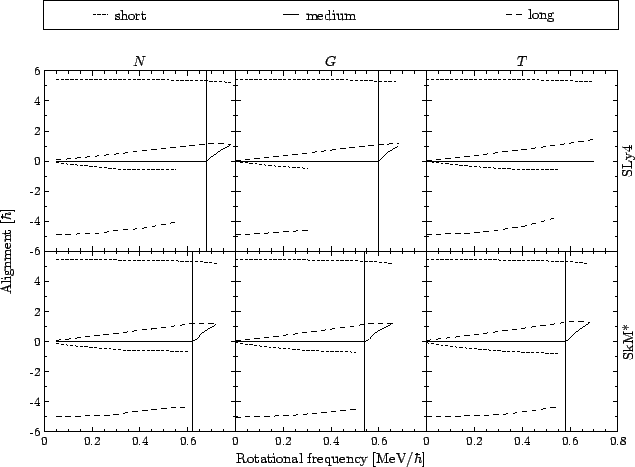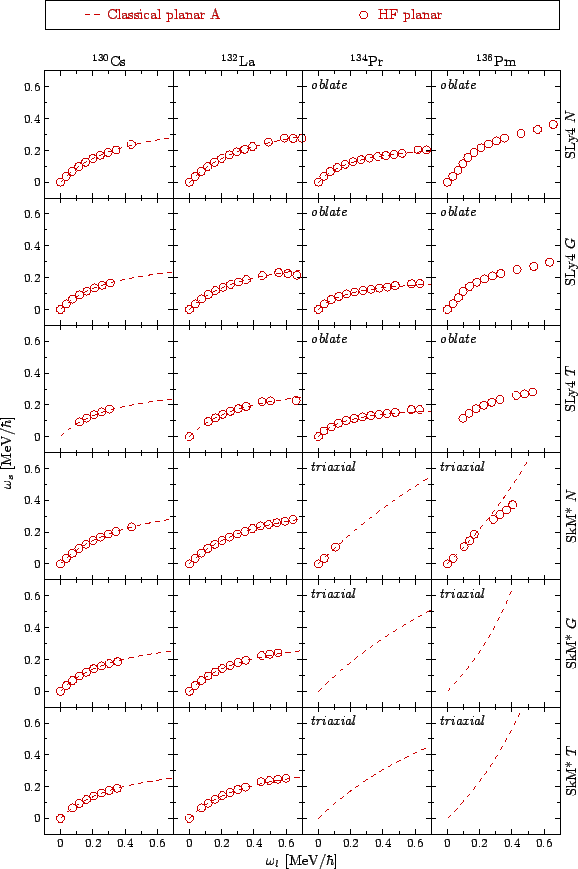We began our self-consistent TAC calculations by finding planar
solutions corresponding to the classical band A. The first point of
each band of this kind was obtained by restarting the HF iterations from the
previously converged non-rotating solution and by applying the
initial cranking frequency vector with non-zero components on its
short and long intrinsic axes. Once convergence was achieved, the
obtained solution served in turn as the starting point for the next value
of the rotational frequency. We proceeded in this way with the
frequency step of 0.05MeV/![]() . We followed each band
diabatically, i.e., by exciting particles near the Fermi level
whenever an empty and an occupied s.p. level of the same parity
were about to cross, so that always the states with the same physical
properties were occupied.
. We followed each band
diabatically, i.e., by exciting particles near the Fermi level
whenever an empty and an occupied s.p. level of the same parity
were about to cross, so that always the states with the same physical
properties were occupied.

|
In the solutions corresponding to a planar rotation, the cranking
frequency vector had non-zero components on the short and long
intrinsic axes in the self-consistent results. To give some insight
into the s.p. structure of those solutions, in Fig. 6
we give the proton and neutron s.p. Routhians for the planar band in
![]() La obtained with the SkM* force and no time-odd fields. Parts
of the plots to the left of the thin vertical lines are relevant for the planar results.
Contrary to the PAC Routhians of Fig. 2, now both the
lowest and the highest
La obtained with the SkM* force and no time-odd fields. Parts
of the plots to the left of the thin vertical lines are relevant for the planar results.
Contrary to the PAC Routhians of Fig. 2, now both the
lowest and the highest ![]() levels split with rotational
frequency. This is consistent with the picture that the valence
particle and hole angular momenta,
levels split with rotational
frequency. This is consistent with the picture that the valence
particle and hole angular momenta,
![]() and
and
![]() ,
aligned on the short and long axes, respectively, now both have
non-zero projections on the tilted axis of rotation.
,
aligned on the short and long axes, respectively, now both have
non-zero projections on the tilted axis of rotation.

|
In order to examine the angular momenta of the valence nucleons,
![]() and
and
![]() , in Fig. 7 we plot their
projections onto the short (dotted line), medium (solid line) and long (dashed line)
intrinsic axes, for all the self-consistent
solutions in
, in Fig. 7 we plot their
projections onto the short (dotted line), medium (solid line) and long (dashed line)
intrinsic axes, for all the self-consistent
solutions in ![]() La. The positive and negative alignments
are those of the lowest proton and highest neutron
La. The positive and negative alignments
are those of the lowest proton and highest neutron ![]() levels;
the latter can be considered as representing
levels;
the latter can be considered as representing
![]() . Parts of
the plots to the left of the thin vertical lines concern the planar bands.
It can be seen that, indeed, the proton particle and the neutron hole
align their angular momenta on the short and long axes. Furthermore,
those alignments change rather weakly with rotational frequency which
means that the wave-functions are strongly confined by deformation
(deformation alignment).
. Parts of
the plots to the left of the thin vertical lines concern the planar bands.
It can be seen that, indeed, the proton particle and the neutron hole
align their angular momenta on the short and long axes. Furthermore,
those alignments change rather weakly with rotational frequency which
means that the wave-functions are strongly confined by deformation
(deformation alignment).

|
It is worth emphasizing that the intrinsic-frame trajectories of
![]() along the self-consistent bands almost exactly follow
the classical ones, in all the considered cases. This is
illustrated in Fig. 8, where the dashed lines
represent classical A bands with parameters of
Table 1, and the HF results are marked with open
circles. For the oblate bands in
along the self-consistent bands almost exactly follow
the classical ones, in all the considered cases. This is
illustrated in Fig. 8, where the dashed lines
represent classical A bands with parameters of
Table 1, and the HF results are marked with open
circles. For the oblate bands in ![]() Pm the classical line
is not shown because the parameters
Pm the classical line
is not shown because the parameters
![]() and
and ![]() could not be
unambiguously extracted from the PAC calculations; see
Section 3.4. However, the HF results follow a curve that
very much resembles the classical hyperbola. For the triaxial
minima in
could not be
unambiguously extracted from the PAC calculations; see
Section 3.4. However, the HF results follow a curve that
very much resembles the classical hyperbola. For the triaxial
minima in ![]() Pr and
Pr and ![]() Pm, no self-consistent planar bands
could be obtained because of multiple level crossings.
Pm, no self-consistent planar bands
could be obtained because of multiple level crossings.
Energy in function of spin also shows a striking agreement between
the classical and self-consistent results for the planar bands. This
can be traced in the case of ![]() La in Fig. 1,
by following the same symbols as those in Fig. 8. Some
deviations are visible only for rather high angular momenta.
La in Fig. 1,
by following the same symbols as those in Fig. 8. Some
deviations are visible only for rather high angular momenta.